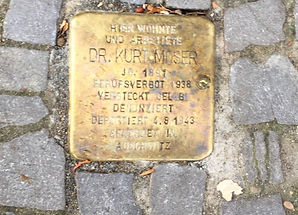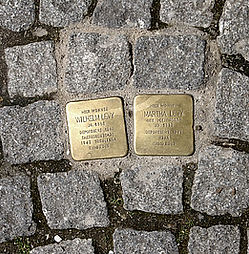
Stolpersteine

QUOTE
“The Holocaust memorial in Berlin will always remain abstract. You have to make the decision to visit it, but not with the stumbling blocks. Suddenly they are there, right outside your front door, at your feet, in front of you”.
- Demnig

Stolpersteine is translated as ‘stumbling stones’ and function as mini memorials cemented into the ground, dispersed in 916 places in Germany as well as in Austria, Belgium, Croatia, the Czech Republic, France, Greece, Italy, Hungary, Luxemburg, the Netherlands, Norway, Poland, Romania, Russia, Slovakia, Slovenia, Spain, Switzerland and Ukraine.
The Stolpersteine project, designed by the German artist, Guenther Demnig, started in 1996 as a symbolic art project. The commemorative brass plaques are made by hand in Berlin by Michael Friedrichs-Friedlaender. The project team have consciously decided to keep production very small – in direct opposition to the mass operations that the Nazis engaged in between 1933 and 1945. The project is innately symbolic and is long-term with the plan to continue making and laying stolpersteines over the next years and decades. It is the largest decentralized monument in the world; there are over 30,000 commemorative pavement blocks which serve to remember victims in the Nazi oppression.
The stolpersteine are situated outside each victim’s last known residence. The blocks are usually engraved with the heading ‘HERE LIVED’ and then contain varying amounts of information but the majority of blocks include the victim’s name, date of birth, date of arrest/murder and location of arrest/death, albeit if applicable. The project is reliant upon local residents, families of victims, schools and religious and secular groups to research the victims and what happened to victims. This creates a local dimension to the memorials and is a really personal way of remembering people who did not survive the Shoah.
BACKGROUND

STOLPERSTEINE AS A COUNTER MONUMENT
The task of remembering Berlin’s involvement in every location and every person who was affected by the Shoah is a virtually implausible and impossible task. Nevertheless, the installation of stolpersteines is a successful way of grasping the widespread reality of historic Nazi presence. The small brass plaques have been implanted into the pavements of residential neighbourhoods, side streets, outside houses, offices and other ordinary places which are passed as part of a daily routine. This illustrates the localness of where terror began and operated and provides a way in which contemporary Berlin can outline the close proximity of Nazi operation, literally having taken place on people’s doorsteps.
The commemorative plaques in the ground are a particularly powerful memory aid as it catches the interest of passers-by. The memorial can take people by surprise and can to some extent alter their normal routine as individuals pause their venture to read and attempt to understand the historic events that took place at the exact location of the plaque; in stopping and pausing daily life the memorial changes their behaviour. Ideally the stolpersteine should stimulate interest and inspire people to research further into what took place in their local area thus forming a close synergy between the Holocaust victim and the modern-day passer-by. The proximity of the stolpersteine makes the victims dramatic fate seem so close and personal. By placing the stones in everyday places in contemporary Berlin it makes it possible to effectively juxtapose Berlin during the Nazi regime and Berlin in the present day; viewers can reflect on the entirely contrasting ways of life. The act of stumbling upon these commemorative blocks suddenly renders the past to become physically present and eternalizes the lives that were lost in the tragedy of the Shoah.
The audience of this memorial is substantially different to traditional memorials which are treated as sacred, removed from daily life. Stolpersteines target locals, people who may be less inclined to go to the visible national monuments. The blocks generate interest in the communities where they are placed: new plaques are welcomed by dedication ceremonies and in some cities groups gather to clean them.
QUOTE
"A person is only forgotten when his or her name is forgotten".
- DEMNIG CITING THE TALMUD

©Karin Richert

©Karin Richert

©Karin Richert

©Karin Richert
REMEMBERING INDIVIDUALS
The stones specifically pay tribute to individuals – names are too often forgotten when considering events like the Shoah, on such a vast scale. The stolpersteines attempt to give the victim back their names, a freedom which the Nazis took away when reducing prisoners to identification by a number.
The stolpersteine has similarities to a gravestone, another right which victims were deprived of, and through having the commemorative plaque it can serve as a constant reminder to each individual who tragically lost their lives during the Holocaust.


PRESENCE OF STOLPERSTEINES
There is not a lot of educational content in the stolpersteines, but the short amount of words signifies a shorter time commitment in viewing the memorial, and over time there is a collective impact as more and more brass plaques are stumbled across, thus witnessing more of Berlin’s landscape which was involved in Nazi life and elucidating the widespread impact of the regime.
It can initiate an uncomfortable confrontation between the what occurred at that location during the Shoah and the people who currently use the space. Those targeted could be living or working in the victims’ former homes or in their neighbourhoods. It changes the normal behaviour of people passing by to that of an individual’s behaviour expected in sacred spaces.
The majority of stolpersteines commemorate Jewish victims of the Holocaust, but there are also blocks which have been placed for Sinti and Romani people, homosexuals, Jehovah’s Witnesses, black people, members of the Communist Part, anti-Nazi Resistance and the physically and mentally disabled, anyone who was persecuted or murdered by the National Socialists between 1933-1945. Stolpersteine are not only placed for people who died but also for survivors.

